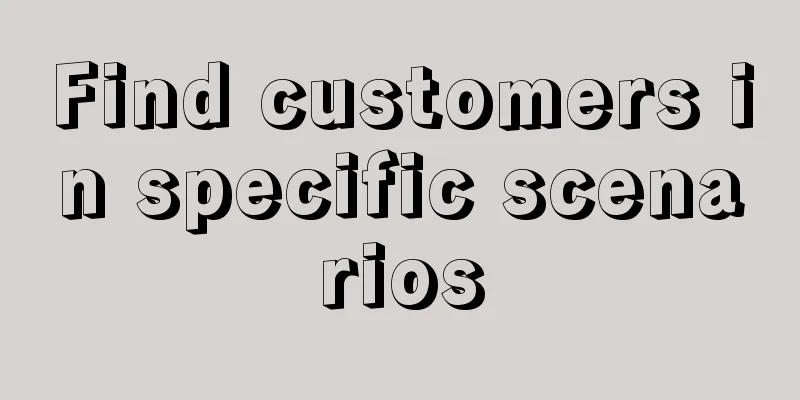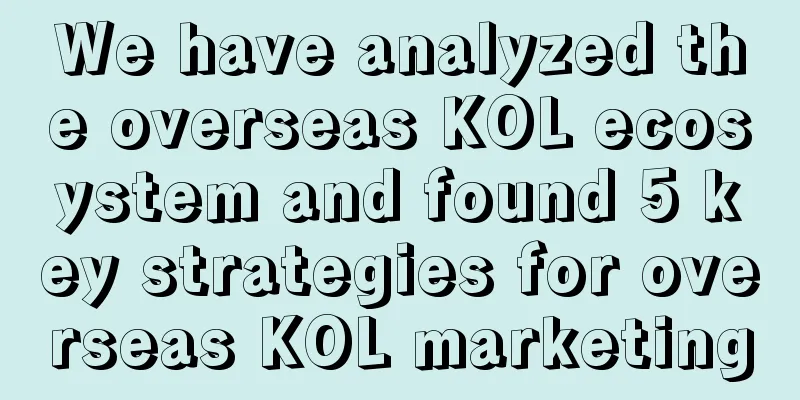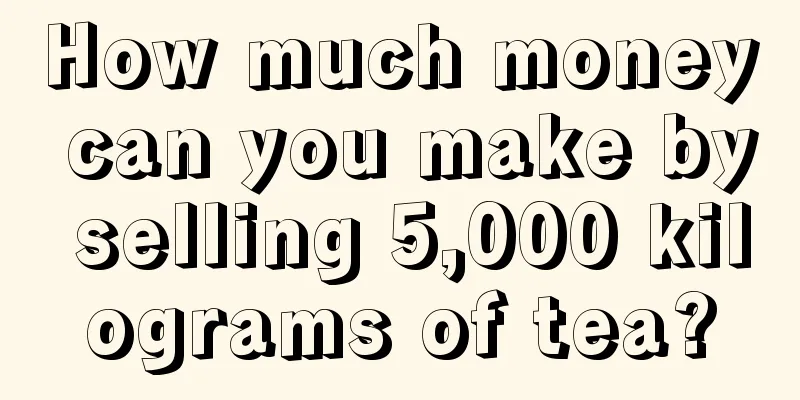Find customers in specific scenarios

I'm numb. What happened? My friend said: It’s too difficult to work on brand strategy in a company now. Many models, such as the AARRR model, REAN model, and 5A model, all use the same method to attract customers, but it seems that they are no longer effective, and the results are getting worse and worse. There are also endless levels of market technology, from big models to AI creative marketing, new tools are emerging one after another to chase creative hotspots, which will disappear soon. If you don't chase them, there is no better way. I understand his feelings very well. Now all industries have entered a no-man's land. First, the information cocoon is serious. Last week, did you read the public opinion that Dong Mingzhu said that people over 35 years old can choose to start their own business if they don’t want to work for a company? Some of my friends were talking about it, while others didn’t know anything at all. Second, traditional marketing methods are ineffective. Others' marketing strategies seem to be successful, and we try to imitate them, but we find that they are difficult to copy. My friend said, I am thinking: How can I spend my money wisely? How can I find my core users and let them know me first? How can I ensure every penny and maximize compound interest from product effectiveness and sales? It is not difficult to solve these problems. As long as you master the underlying rules of market and user insights, you can easily develop a good content marketing strategy. I have sorted out the chat records of the two people, a total of four points, and I would like to share them with you. If your work is related to strategy and your company happens to make products with medium to high unit prices, such as: B-end tools, home ventilators, facial SPA devices, etc., you can take a look and I believe you will get new inspiration. 01Let’s talk about a word first: mission What is a mission? To answer this question, we need to think back to consumer behavior, because it is the cornerstone of all marketing promotion and brand building. When we do marketing, we first focus on the user's purchase journey, which is in the following order: task > information collection > comparison and evaluation > purchase > sharing. Throughout the process, brands need to find various opportunities to engage with users. Why is task ranked first? Because all tasks of a user are basically driven by specific needs and desires in life, as well as self-cognition and lifestyle. for example: Some time ago, I wanted to buy a pair of headphones. The reason for this decision was that my old headphones were broken, and I couldn't stand the external noise when I was working. At the same time, I also wanted to find a pair of headphones that would give me a strong HIFI feel for daily listening. Therefore, my requirements were good sound quality and strong noise reduction. Did you see it? A task is an action or goal that a user completes to meet a need or problem. Have you noticed a trend? In the past few decades, many brands have shifted from making large and comprehensive products to making small and exquisite products, or focusing on specific areas of products. Why is this? The reason is that in the past when supply was scarce, there was less competition in the market and one company could basically serve everyone. However, as time goes by, more and more brands emerge, and competition naturally becomes more intense. Therefore, behind the increasing involution, brands have to look for specific customer groups to increase their market share. For example: A brand may initially focus on the female market, and then further refine it to focus on working women. Later, the market was further divided into sub-groups such as independent women, young mothers and middle-aged mothers. I went to buy shampoo a while ago and was surprised. In the past, I thought that shampoo only needed to remove dandruff; but now, there are products on the market that have various functions such as removing dandruff, softening hair, nourishing and repairing hair, and preventing hair loss. Moreover, the products are classified according to different needs such as men, women, oily hair, dry hair, etc. In the past two years, Yuanqi Forest has given me a lot of inspiration. It initially developed hundreds of products, but most of them failed, and only the burning tea and sparkling water were successful. Because in the beverage market, the mainstream categories have been occupied by other big brands, he can only focus on the niche sugar-free and sparkling beverage market. But facing the limited size of the market segment, what should brands do? Try to expand the small category they created and occupy a place in the big market through precise crowd positioning. Many brands have adopted this strategy, such as Meiji Landou and Olivilan. The rules behind it all come from the increment of scene creation. This is the first point, task-driven, focusing on tasks. 02The second point is: stay away from noise, pay less attention to competitors, and pay more attention to scenarios. Why? Because there are specific needs in the scene. Imagine if you want to know whether a facial SPA device or a certain tool is good to use, what is your first motivation? As expected, there are two answers: one is interest-driven, and the other is demand-driven. Interest is like suddenly seeing an advertisement with an attractive page design. Although you have never seen it before, curiosity prompts you to click in and explore more. It's like opening Pandora's box, letting you involuntarily understand what it is. The disadvantage is that if you are not interested after understanding it, you will never look at it again. Demand-driven is different. It is based on urgent needs in reality. When you feel hungry at 12 noon, your first reaction is to find something to eat. At this time, it doesn't matter whether it is stir-fry or hot pot, as long as it can solve your hunger, anything is fine. This need starts from a personal standpoint and prompts you to take action to solve the problem. Obviously, to truly understand the requirements, you need to set a specific scenario. So, what is a need? Simply put: a problem that a person wants to solve in a specific context, a goal to achieve is a need; in other words, it is a task that he wants to complete. A while ago, a colleague from the marketing department of a large model company asked a question: Why did the market not respond to our company's promotion of large-scale model products? I said: Because potential users don't know how to use the technology, where to use it, and what problems to solve. If we say that our technology can help you solve the problem of low efficiency of online customer service, you can quickly improve the response efficiency by 400% by just using a simple API to connect your knowledge base. So, will such brand communication attract the attention of the "boss"? Therefore, only in a clear scenario can people turn vague ideas into specific needs. Different scenarios require different solutions. Only in a specific scenario can we truly see the specific needs. Remember this: clarifying the scenario and specific needs is equivalent to quantifying the task; however, users have needs, and they do not necessarily require perfect solutions. What's the meaning? If you have a piece of bread and I am hungry, and you sell it to me, I might buy it. Hunger is a demand. However, when I am hungry, I don’t necessarily have to eat bread, and bread is not necessarily the best solution. In other words, demand is a solution proposed based on the scenario. We do not need to pursue the best solution, as long as we find the right one. If I am given bread at 12 noon, I will probably not eat it. But if I am given bread in the evening, I might choose it. If you still don’t understand, let me give you two more examples. One is: when a customer buys an electric drill, it is actually because he needs to drill a hole in the wall. Drilling a hole is a demand. Another is: people work to earn money, not because the money itself is a demand, but because the money can be exchanged for what they want. The things and resources behind it are the most precious and are the demand. Therefore, finding the real needs is more important than simply satisfying superficial needs. 03When talking about this, the other party mentioned a key word that was confused by the needs: pain point. What are the pain points? The feeling of satisfaction and discomfort. For example, if you find that your mobile phone battery needs to be charged before it lasts a whole day, then battery life is a pain point; a pain point is a demand that urgently needs to be met, but the market cannot fully meet it yet. In other words, the current solution is not working and we need to find a more perfect one. A few days ago, I went hiking with a friend and talked about photography. He mentioned that he was planning to buy a camera to take some nice videos and beautiful views while traveling. I was a little confused, so I asked him, "Mobile phone photography technology is so good now, isn't it enough?" He shook his head and said, "Indeed, mobile phone photography is very convenient, but the image quality and functions are still not as good as professional cameras." He went on to say: “But the camera also has its problems. First, it is too heavy to carry. Second, the battery life is a big problem. If I want to take long-term photos such as sunrise and sunset, I have to get several batteries. I should buy a mirrorless camera, but the money is not worth it, and some of its functions are not as good as those of a mobile phone. You see, what is the demand? What is the pain point? The demand is that you need a portable camera that can take high-quality photos and videos; the pain point is that the camera is heavy, has a short battery life, and is entangled. If you can understand the pain points, you can also understand the pleasure points and the itch points. The itch point is to satisfy the deep needs in our hearts. For example, WeChat’s Moments not only helps us solve our desire to pay attention to other people’s lives, but also satisfies our need to show ourselves and get praise. The cool part is about things that make people feel good immediately, like a friend you haven’t contacted for a long time suddenly sending you a message or posting a circle of friends, and receiving a lot of likes. When we identify needs and pain points, we must be careful not to stray from the topic and not misunderstand what is the itch point and the pleasure point. The pain point is the best solution provided to users based on the needs. If you can meet the needs, then there is a value exchange; if you can solve the pain points, then this value exchange is even more significant. So, my idea is this: task > needs > pain points > itch points. This is the third point. Don’t just talk about how good your product is. No matter how good it is, it is not as good as “you have captured many scenarios.” The so-called scenario refers to what needs to be done in a specific context. 04So, what is the fourth point? Three words: specific people Look at my experience. Last month, I went back to my hometown with my dad. Since I grew up, I rarely have the opportunity to sleep in the same bed with my parents. That time, I was in a hurry and didn't have time to clean my room, so I slept with my dad. At night, I found that he was snoring very badly, which made me unable to sleep well all night. Considering the situation, I originally wanted to buy him a ventilator and put it at home to help him improve his sleep, but I knew that he would definitely not accept it because, at his age, if he lay in bed with a ventilator, he would feel that I was cursing him. Later, I chose a compromise and bought a few boxes of anti-snoring spray online. After he used it, the effect was quite good. He told me in surprise: There is such a magical thing on the Internet? (He can shop, but he didn't know it). You can see that although my dad is the one who uses the anti-snoring spray, he himself may not be aware of the problem of snoring, or he may not know that a small thing worth dozens of dollars can temporarily alleviate this problem. I was the one who actually bought it. Therefore, “specific persons” include direct beneficiaries and indirect beneficiaries. This is very typical in practical applications, as we can see from the following three key information:
You may ask, what does this have to do with me? Don’t worry, for products with medium to high unit price, especially those targeting enterprises (B-side), the decision logic is usually like this:
Therefore, we should not ignore the needs and status of two types of people. I have observed that generally speaking, there are three types of specific people: The first type is that some people simply don’t know that there is a better solution. This involves two issues: "really not knowing" and "awakening". The so-called "really not knowing" means that they have not even been exposed to relevant information. As for "awakening", it means that although these people know some ways to solve problems, they will not use more efficient tools to replace traditional practices. The second type is that he knows how to solve his problem, but the method he uses is not very good, and he doesn’t know what good tools to use. For example, farm irrigation. In the past, people had to manually lay water pipes to irrigate the land. Now there are automatic sprinkler irrigation, which is much more convenient. But if they don’t know how to use it, they will still use the old method. The third type is that the user is very clear about the problem and the solution, but cannot make the decision himself. In other words, the final decision-making power is in the hands of a higher-level person, who has his own starting point. For example, in the family, no matter how good the man thinks the car is, sometimes the woman has to make the final decision. Obviously, for the B-side, everyone in the task chain is important. So, what conclusions can we draw from the four aspects of tasks, scenarios, pain points, and specific people? First, do not look for needs separately. The incremental needs are all in the tasks, and tasks come first. Second, the scenarios are critical, which can be divided into rigid demand scenarios and non-rigid demand scenarios. For example, in the entertainment scenario, consumers' demand for iPad may be much stronger than that in the office scenario. In the mobile office scenario, iPad can partially replace PC. Third, don’t try to solve the pain points, nor should you prescribe the right medicine for the pain points. Instead, try to provide the most cost-effective solution based on the needs. Fourth, pay more attention to specific people. Sometimes, on the same task, the boss, employees, and managers have completely different views. In this way, we can not only better understand the market and users, but also formulate content strategies more accurately. In summaryPay more attention to the scenario and less to the needs. Scenarios are solutions to tasks. In those untapped tasks, there are incremental gains. Just like eating, it seems to be a basic life need, but who to eat with, what to eat, and where to eat are all different tasks. Different tasks lead to different choices. Author: Wang Zhiyuan Source public account: Wang Zhiyuan (ID: 878436) |
<<: Today's Taobao is even more popular than Pinduoduo
>>: Revealed! Behind the sale of a pillow for 300 million yuan on Xiaohongshu Blue Ocean Sleep
Recommend
Understand in 5 steps - How to create a closed loop of private domain transactions worth tens of millions!
In today's business environment, the importanc...
Shuyi’s male sex marketing is comparable to Coco Tree!
Since the Coco Tree live broadcast room became pop...
What is the difference between Amazon replenishment limits and warehouse capacity?
Merchants who open stores on Amazon will definitel...
"Internet celebrity with millions of fans" Xiucai title: neglected emotions of middle-aged and elderly people and the neglected silver hair market
Xiucai, who frequently appears in shy actions, has...
Heytea is competing for the Paris market, Yili is “buying shares in advance”…are these “fancy ways” of Olympic marketing?
The 2024 Paris Olympics is about to kick off. Its ...
Dialogue with the "Chongqing Internet Celebrity" Buqi Dance Troupe: After 5 years in the short video industry, how to iterate content?
What is the core of short video operation and inno...
Millions of paying users, performance rising against the trend, in-depth analysis of New Oriental membership operations
I believe everyone still remembers the money-burni...
With over 100 million members worldwide and over 90% renewal rate, how did Costco achieve this success?
In the retail market, membership-based supermarket...
Can Shopee Taiwan users apply for a partial refund? What should I do if Shopee does not receive the package?
Shopee is the largest e-commerce platform in South...
In the next decade, brand mission will be more important than brand positioning
A good brand depends on a good positioning. If the...
TikTok has joined the price war, but which sheep is being fleeced?
Now more and more platforms are engaging in price ...
The worse your ability, the more confident you are? Understanding these things when writing a plan will help you avoid taking detours
When you meet someone who "does not listen, c...
Does Lazada need to consider VAT when calculating prices? How to set prices?
Lazada is still gaining momentum in Southeast Asia...
Is it better to make short videos than to place advertisements? The data tells you the answer!
In the wave of digital marketing, which one is bet...
Single-day GMV of 416 million, who benefited from the World Cup on Douyin
This article deeply analyzes how Douyin, a life se...









